Exploring the Depths of Chinese Tarot Cards
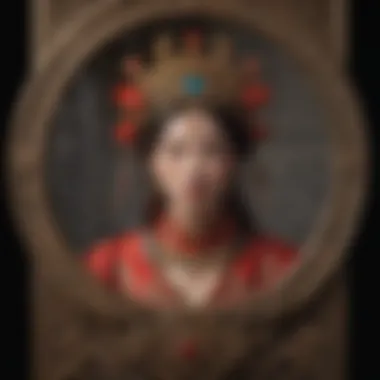
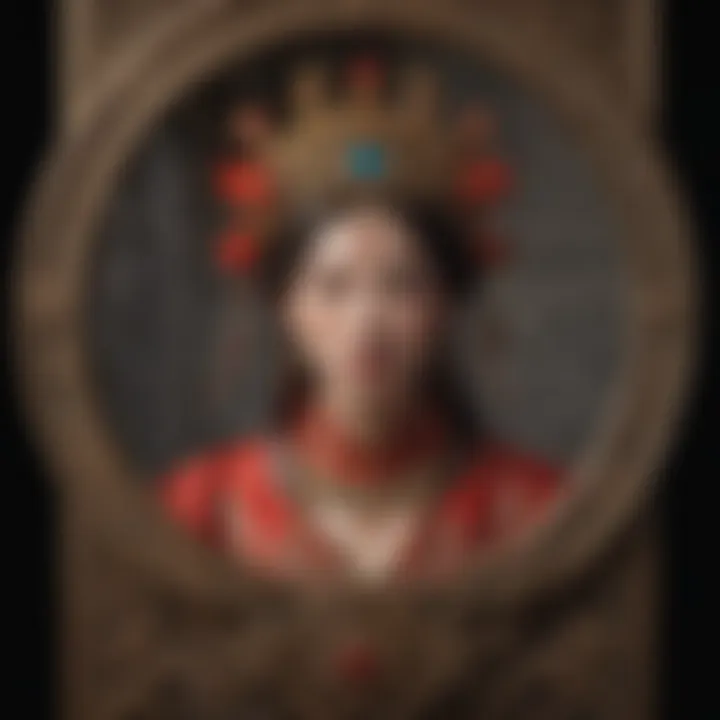
Intro
Diving into the world of Chinese tarot cards brings to light a fascinating tapestry of tradition, mystique, and personal reflection. Unlike Western tarot, which often captivates audiences with its vivid imagery and archetypal representations, Chinese tarot possesses a unique flavor, deeply embedded in the cultural and philosophical landscape of China. This divergence is the starting point for understanding the principles and interpretations that govern these cards.
What makes Chinese tarot cards especially intriguing is their intertwining with elements of traditional Chinese beliefs, such as Confucianism, Taoism, and Buddhism. Each card isn’t merely a tool for divination but rather a reflection of a broader narrative that speaks to individual experiences, relationships, and the ongoing journey through life. As we explore the principles behind these cards, the insights gleaned from their interpretations promise to be both enlightening and grounding for practitioners in search of spiritual guidance.
By juxtaposing the characteristics of Chinese tarot with those of its Western counterpart, we begin to unveil the distinct features that define their readings and significance in contemporary spirituality. Within this multifaceted exploration, we aim to offer readers—no matter their prior knowledge—insight into the rich world of Chinese tarot, facilitating a deeper understanding that may just transform how one perceives both tarot and the very essence of personal insight.
Prolusion to Chinese Tarot Cards
Chinese tarot cards represent a rich tapestry woven from history, culture, and spirituality. The introduction of this intriguing subject sets the stage for a nuanced understanding of how these cards function, not merely as tools for divination but as a bridge connecting individuals to deeper aspects of themselves and their surroundings.
Understanding the Essence of Tarot
At its core, tarot transcends mere card reading. It embodies a system of reflection, encouraging individuals to tap into their intuition and consciousness. Chinese tarot cards, distinct in their symbolic language, offer insights that are aligned with traditional wisdom and practices. Each card resonates with specific meanings, often intertwined with philosophical concepts that are central to Chinese culture.
Understanding these nuances helps practitioners grasp the deeper layers of interpretation, fostering an environment where guidance and self-discovery thrive. When one engages with these cards, it's not just about predicting the future but about uncovering the stories and messages that the universe holds.
The Evolution of Tarot in China
The history of tarot in China is not just a flat line; it twists and turns, adapting to various cultural shifts and philosophical influences over centuries. Initially, tarot-like practices appeared in Asian cultures, where divination was integrated deeply into daily life. As ideas flowed between East and West, tarot took different shapes.
In China, tarot merged with local traditions and philosophies, creating unique variants that reflect both heritage and contemporary spiritual needs. This evolution mirrors broader societal changes, encapsulating a journey from ancient wisdom to modern practices. Understanding this context not only enriches one's tarot reading but also places it within broader historical dialogues, revealing its adaptability and timeless relevance.
Ultimately, exploring Chinese tarot cards involves delving into more than just the images on the cards; it invites us to engage with the profound shifts in thought and belief that have shaped their narrative. With this foundational understanding, readers can further appreciate the layers of meaning and significance these cards represent in both historical and modern contexts.
Historical Context and Cultural Significance
Understanding the historical context and cultural significance of Chinese tarot cards allows for a deeper appreciation of their complexity and relevance in today's spiritual landscape. It’s not just about drawing cards and seeking answers; it’s about connecting with centuries of tradition and philosophies that influence the way these cards are interpreted. The rich tapestry of Chinese history weaves together the narratives around tarot practices imported and evolved within the society. Growing awareness of this context allows practitioners to engage with tarot on a profound level, illuminating how culture shapes spirituality and divination practices.
Origins of Tarot Practices in China
The journey of tarot in China appears to intertwine with various historical threads, often merging with indigenous beliefs and external influences. It is said that tarot's seeds were sown when Western practices met Eastern cultural dynamics. This phase of blending began mainly in the late Qing dynasty when foreign books and ideas trickled into the Chinese consciousness. Over time, the tarot joined hands with local forms of divination, such as the I Ching and Feng Shui, creating a uniquely Chinese interpretation of tarot that both resonates and enriches the tradition.
The adoption of tarot was not merely about implementing a new system; it involved layers of interpretation that embedded local symbolism and practices. For instance, while traditional Western tarot embraces the Major and Minor Arcana, many Chinese tarot decks integrate familial structures, reflecting the importance of kinship in Chinese culture. This nuanced adoption ensures the practice is not merely an echo of Western systems but a vibrant, living tradition that aligns closely with its cultural milieu.
Integration with Chinese Philosophies
Confucianism
Confucianism emphasizes moral integrity and social harmony—ideals that spill into the practice of tarot reading in China. Readers often find themselves guided by the principles of righteousness and respect in their interpretations, ensuring that the insights gained foster balance and ethical considerations. Confucian thought encourages a focus on interpersonal relationships, which can influence how cards are understood in context to one's social environments, rather than mere individual pursuits. This incorporation not only offers a solid ethical framework but also enhances the communal aspect of tarot as a transformative medium.
According to Confucius, understanding one's role within society is pivotal. This makes the reflective aspect of tarot particularly useful; it becomes not just a tool for prediction but a mirror reflecting the reader's societal position and responsibilities.
Taoism
Taoism introduces a fluidity that contrasts with the rigidity sometimes found in Western practices. The Taoist perspective embraces the balance of yin and yang, highlighting the natural order of the universe, which becomes pivotal during readings. The interaction of opposing forces as represented in tarot cards can reveal insights about the balance or imbalance present in one’s life.
Taoist philosophy resonates with the cyclical nature of both tarot interpretations and the human experience. This philosophy encourages practitioners to accept transitions and embrace change, which plays a vital role in personal evolution. Thus, the application of Taoist principles enhances the tarot experience, pushing for adaptability while being grounded in one's truth.
Buddhism
Buddhism contributes views on impermanence and attachment, enriching the practice of Chinese tarot with a perspective on the transient nature of existence. In this light, tarot readings can serve as gentle reminders that no situation is static; understanding and acceptance are key to navigating life's challenges. Each card drawn can signify more than just a static position; rather, it can reflect shifting energies and perspectives.
Moreover, the focus on mindfulness in Buddhism allows readers to engage with tarot in a way that isn't just about divining the future but understanding the present moment. It encourages being fully present during a reading, fostering a more profound connection with the cards that transcend traditional interpretations.
By weaving these principles into the practices of tarot, we find that not only are interpretations enriched, but they also resonate more deeply with individuals' lived realities, shaping the experience of self-exploration and insight that is paramount to tarot's transformative power.
Unique Characteristics of Chinese Tarot Cards
Understanding the unique characteristics of Chinese tarot cards is essential for both aspiring and seasoned practitioners. These cards are not just a means to tell fortunes; they encompass layers of cultural significance and artistic expression that deepen the reading experience. From the symbols used to the structural elements of the decks, every feature plays a role in conveying messages that go well beyond surface-level interpretations.
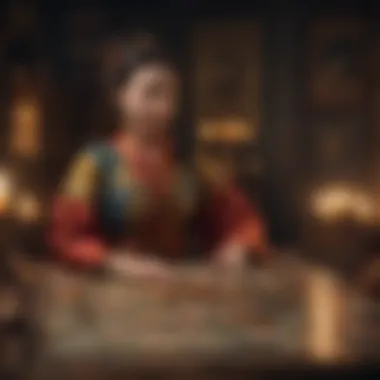
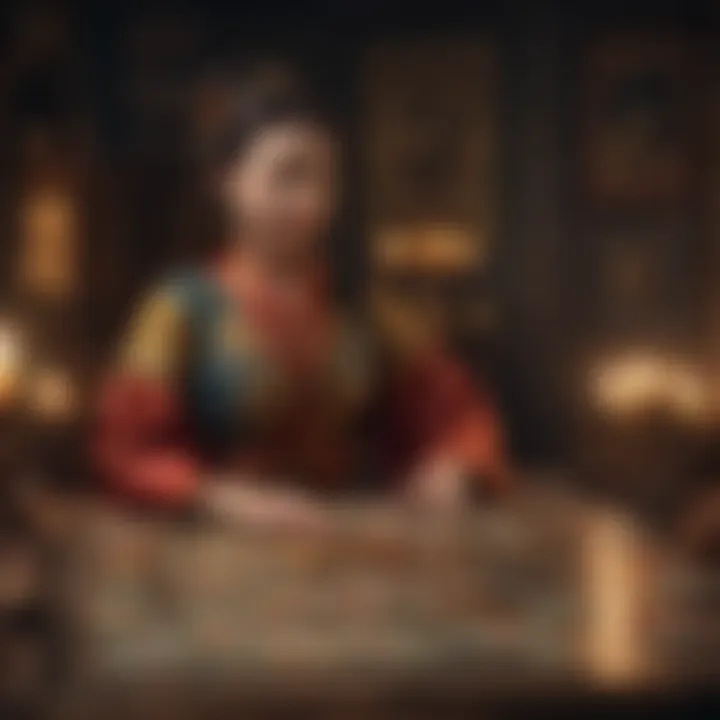
Symbolism and Imagery
Animal Symbols
Animal symbols in Chinese tarot are rich with meaning and cultural heritage. Each animal often embodies specific traits and energies that can guide interpretations during readings. For instance, the dragon symbolizes strength and wisdom, while the phoenix is associated with rebirth and transformation. These representations are not merely decorative but serve as conduits for connecting users to deeper insights about themselves and their circumstances.
One key characteristic of animal symbols is their ability to resonate on personal levels. When a dragon card appears in a spread, it might evoke personal strength or the need to confront challenges head-on. This is beneficial for the reading process as it encourages introspection and self-empowerment.
However, while these animal symbols can enhance the reading experience, they can also pose challenges. For someone unfamiliar with their significance, interpretations might miss the mark. Understanding the nuances behind each symbol is necessary to maximize their advantages.
Elemental Representations
Elemental representations in Chinese tarot add another layer of complexity and insight. The four classical elements—Earth, Fire, Water, and Wood—are integral to many interpretations. Each element embodies different qualities and influences in life and, when drawn, can indicate where energies are flowing or what might be blocked.
A notable feature of elemental representations is how they guide readers through various situations. For example, a Fire card might suggest passion and energy but also warn of impulsiveness. This duality can serve as an instructive component, offering pragmatic guidance rather than just predictions.
However, a downside might arise if a reader overly fixates on these representations without considering the personal context of the querent. Balancing elemental meanings with individual narratives is essential. Overall, when applied mindfully, elemental representations can unlock deeper insights into personal dynamics and life decisions.
Structure and Composition
Deck Size
The deck size of Chinese tarot cards is often smaller and more compact compared to Western decks. Typically consisting of around 78 cards, this size is designed for ease of handling and shuffling, allowing for fluidity during readings. The convenient size also makes these cards accessible to a wider audience, giving anyone the chance to engage with this rich tradition.
What makes the deck size noteworthy is its influence on card combinations and spreads. A smaller deck provides a different dynamic and encourages creativity in how the cards interact during readings. This flexibility can lead to unexpected insights, making it a popular format for many practitioners.
However, the compact nature of the decks can also limit diversity. With fewer cards, there might be less room for distinct interpretations or themes compared to larger decks. Thus, understanding the dynamics and limitations of the deck size becomes increasingly significant for any effective reading.
Card Types
Card types within Chinese tarot decks can vary widely, often embodying themes drawn from Chinese mythology, folklore, and philosophical principles. Common types include the Major Arcana—typically depicting powerful archetypes—and the Minor Arcana, which delve into everyday challenges and influences. Each type addresses unique aspects of life’s journey.
The key feature of card types is their thematic diversity. This allows readers to access a broad spectrum of experiences and energies, making their readings greatly nuanced. For instance, a card representing an ancient sage may evoke wisdom, while a card depicting a young warrior suggests a time for action and courage.
However, the diverse themes presented may overwhelm novice readers. It’s vital to establish a clear understanding of each card type’s meanings and how they relate to the overall reading. A methodical approach can help manage interpretations effectively while harnessing the full potential of the card types present.
In summary, the unique characteristics of Chinese tarot cards, from symbolism and imagery to structure and composition, create a multi-faceted tool for exploration and insight. Understanding these aspects is crucial for maximizing the effectiveness of readings.
Each characteristic offers its own opportunities and challenges, highlighting the importance of a comprehensive understanding for anyone delving into the world of Chinese tarot.
Reading Chinese Tarot Cards
Understanding how to read Chinese tarot cards plays a fundamental role in both the practitioners’ growth and the connections they can create with the deeper meanings embedded in the cards. When stepping into the rich world of Chinese tarot, practitioners often find that the process is not simply about interpreting symbols but also a bridge to self-discovery. Through readings, individuals can glean insights not just about their circumstances but also about their personal journeys and emotional landscapes.
Reading Chinese tarot cards blends intuition and analytical thinking. This practice encourages one to engage with the cards holistically. Unlike a standardized formulaic approach, the reading requires closeness to spiritual energies and the ability to tap into one's personal resonance with the symbols presented. A reader is tasked with marrying their intellect to their feelings, creating a personalized narrative that goes beyond mere rote learning.
Basic Techniques for Beginners
For those just dipping their toes into the waters of Chinese tarot, a few foundational techniques can serve as sturdy stepping stones. One commonly employed method is the intuitive method. This simple yet powerful approach encourages beginners to look at the imagery and symbols on the cards and allow themselves to feel what the card invokes rather than relying solely on learned meanings. This taps into one’s inner wisdom without getting lost in complexities.
Another technique is journaling the experience. Both during readings and after, keeping a record can help in tracking patterns and interpretations. Over time, one's insights and experiences will build upon one another, creating a rich dialogue between the practitioner and the cards.
Moreover, familiarizing oneself with the elemental correspondences in the cards enhances understanding. Each card corresponds to different elements, feelings, and life aspects that can further guide the reading.
Advanced Interpretations and Spreads
As one journeys deeper into the art of tarot reading, advanced techniques and spreads become essential tools. Notably, two widely used formats are the Celtic Cross and the Three-Card Spread.
Celtic Cross
The Celtic Cross is well-known for its thoroughness and complexity. This spread invites an expansive view that encompasses multiple aspects of a question or situation. Its structure allows deeper layers of understanding to unfurl, presenting a comprehensive metaphorical map of current circumstances.
The foremost characteristic of the Celtic Cross is its ten-card layout, which provides insight from various angles, ranging from the heart of the question to external influences and potential outcomes. This multi-dimensional lens makes it popular, especially among those wanting to dive deeper into intricate situations. Each card's position carries its weight, outlining not only what is but hinting at what could be. However, this method can be cumbersome for beginners or those who prefer simplicity. It requires a careful study and understanding of each position's meaning.
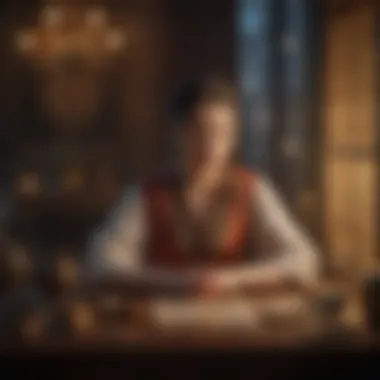
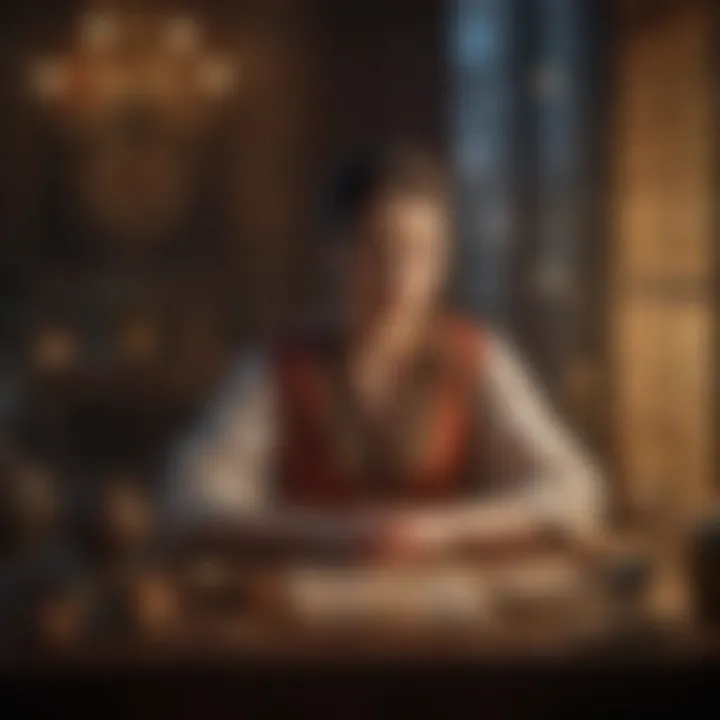
"Reading the Celtic Cross is comparable to navigating a winding river; patience and awareness of the currents will reveal hidden truths."
Three-Card Spread
On the flip side, the Three-Card Spread is often highlighted for its simplicity and versatility. This method focuses on the past, present, and future, making it an excellent choice for those seeking quick insights without overwhelming complexity. It allows individuals to encapsulate a situation in just three symbols, creating an approachable yet effective reading style.
The unique feature of the Three-Card Spread lies in its immediacy. In just a few moments, one can draw cards that represent different temporal perspectives, revealing how the past has shaped the present and what potential futures may lie ahead. This spread is welcoming to newcomers but still contains enough depth to intrigue seasoned practitioners. The downside, however, is that it may lack some of the in-depth analysis that the Celtic Cross offers.
Reading Chinese tarot cards invites practitioners to flow beneath the surface of everyday challenges and introvert in the deeper currents of existence. Finding balance between fundamental techniques and advanced applications offers a way to intertwine tradition and personal insight.
Comparative Analysis: Chinese vs. Western Tarot
Examining the differences and similarities between Chinese and Western tarot provides valuable insights for practitioners and enthusiasts alike. This comparative analysis not only reveals distinctive features of each system, but it also invites a deeper understanding of how cultural contexts shape tarot practices. Within a world increasingly interconnected, recognizing these unique elements can enhance one’s reading experience and personal development. It lays a foundation for a more comprehensive grasp of tarot’s rich tapestry.
Core Differences in Themes
The thematic distinctions between Chinese Tarot and its Western counterpart are notably pronounced. While both systems use cards to symbolize the journey of life, the narratives they weave can be quite different.
- Cultural Influence:
- Symbolic Representation:
- Implementation in Readings:
- In Chinese Tarot, themes often derive from ancient philosophies and myths. Think Confucian values and Taoist principles; they heavily flavor the interpretations, bridging spirituality with practical wisdom. For example, the concept of harmony is prevalent in many readings, reflecting China’s collective societal norms.
- Conversely, Western Tarot leans towards individual exploration. Its archetypes reflect personal challenges, psychological conflicts, and a more direct relationship with fate. The Fool's journey in Western tarot often represents personal growth or self-discovery, which may not resonate as strongly within the Chinese context.
- Chinese Tarot cards might feature elements like dragons, which symbolize strength and authority, or the moon, indicating intuition and change. These symbols embrace both nature and the cosmos, showcasing Chinese beliefs about the interconnectedness of all things.
- Western Tarot cards employ a more varied palette of symbols, from swords indicating conflict to cups representing emotions. Their themes are often more direct and individual-centric, allowing readers to focus on personal experiences.
- When using Chinese Tarot, readings may focus on scenarios affecting the larger community or family, aligning with traditional values. The interpretations might pivot around collective wellbeing rather than solely individual concerns.
- In contrast, Western Tarot readings frequently emphasize personal queries, delving into self-awareness or upcoming obstacles. The question at hand strongly shapes the guidance received from the reading.
These core differences paint a clear picture of how each tarot system embodies its cultural backdrop, ultimately providing unique avenues for insight and direction.
Common Ground and Intersections
Despite their differences, Chinese and Western Tarot boast intersections that can be enlightening for those diving into either practice. Here are some notable points of commonality:
- Archetypal Symbols: Both systems utilize archetypes; these universal symbols ensure that readers can relate to the cards, irrespective of cultural origin. For instance, the concept of the Hero's Journey resonates across both practices, emphasizing personal growth and resilience.
- Intuitive Reading: Whether you’re drawing a card from a Chinese deck or a Western deck, intuition plays a pivotal role. Readers from both schools of thought emphasize the importance of connecting empathetically to the cards and allowing personal interpretations to guide their insights.
- Spiritual Guidance: Both traditions aim to offer guidance, whether it’s navigating life's challenges or understanding oneself more fully. The fundamental purpose of tarot—to provide clarity and insight—remains unchanged, transcending regional boundaries.
- Personal Reflection: At the end of the day, both systems encourage introspection. Although they approach themes from different angles, the underlying goal—a deeper connection with oneself and the universe—is a shared aspiration.
In the realm of tarot, embracing both Chinese and Western forms can enrich one's understanding and practices, offering diverse perspectives on life’s journey.
Through this layered exploration of themes and symbols, readers can appreciate the beauty inherent in each approach, knitting together elements from both traditions for a richer tarot experience.
Applications of Chinese Tarot in Modern Spirituality
The unique attributes and profound symbolism of Chinese tarot cards have carved a niche for themselves in the realm of modern spirituality. This section probes into how these ancient tools have morphed into contemporary resources for growth, reflection, and guidance. By integrating these tarot practices into daily routines, individuals have discovered significant benefits in their personal lives and interactions with others.
Personal Development and Insight
Chinese tarot isn't just about cards in a spread or fortune-telling. It's a robust pathway for self-reflection and personal growth. Each card, rich with cultural symbolism, digs deeper than surface appearances, encouraging individuals to explore their inner landscapes. For instance, drawing the Tao of the Dragon might prompt one to consider leadership, power, and adaptability. The imagery sparks conversations within oneself, lending clarity to confusing emotions and life choices.
Here are some specific ways Chinese tarot fosters personal development:
- Self-Discovery: Engaging with the cards opens doors to understanding one's motivations, fears, and aspirations. This peek into the psyche can lead to transformative moments.
- Mindfulness Practices: Regular readings can cultivate mindfulness, making individuals more present. This has a cascading effect on how they navigate daily stresses, responding rather than reacting.
- Goal Setting: Tarot can act as a guide in setting and adjusting personal goals. For example, drawing the Wise Owl might inspire prioritizing knowledge and skill development in one's professional life.
"The tarot acts like a mirror, reflecting not just who we are now, but who we can endeavor to be."
Ultimately, personal enrichment through Chinese tarot entails acceptance and understanding; this method pushes boundaries and encourages deeper connections between actions and their repercussions.
Utilization in Counseling and Guidance
Counseling practices have gradually embraced Chinese tarot as a tool for insight and healing. Here, the tarot doesn't replace conventional therapies but rather complements them, creating an enriched toolkit for practitioners and clients alike. Integrating tarot into counseling can enhance the understanding of a client's emotional landscape, offering a fresh perspective on lingering issues.
Here’s how Chinese tarot finds its place in counseling and guidance:
- Visual Storytelling: The imagery in tarot can help clients articulate their feelings when words may fail. This narrative could allow both the counselor and client to unpack complex emotions that would otherwise remain dormant.
- Symbolic Interpretation: Just as art therapists use creative processes to elicit responses, tarot symbols can deepen awareness of personal patterns and behaviors. A person drawing The Silent Wolf might unlock themes of solitude, prompting deeper analysis about relationships.
- Empowerment and Agency: Tarot can be used to navigate choices, emphasizing empowerment instead of prediction. By exploring the outcomes of various paths represented in the spread, clients can feel more in control of their lives.
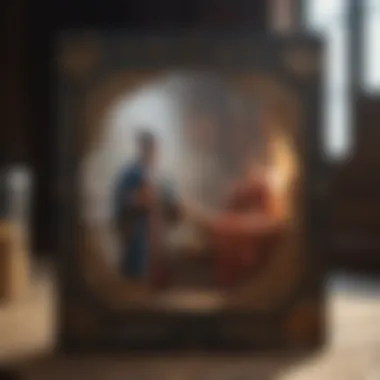
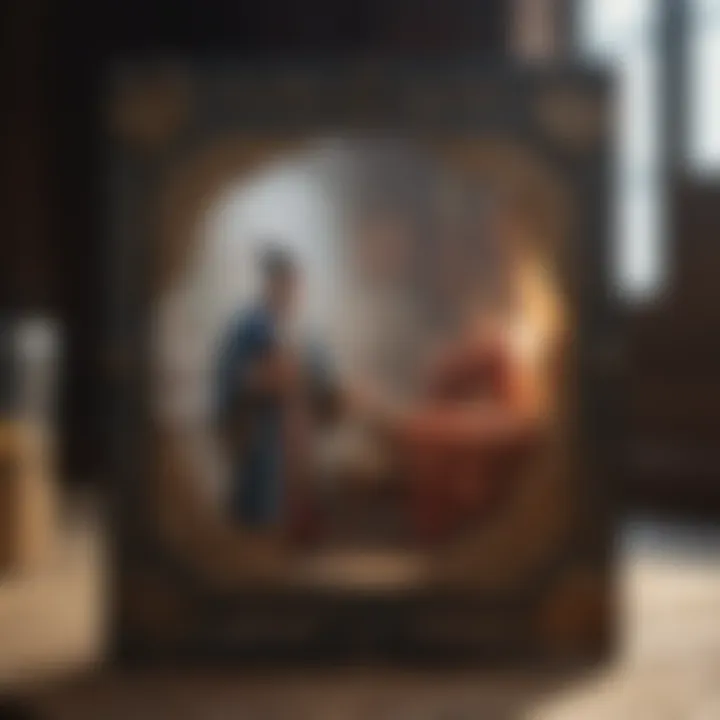
This approach doesn’t just provide insights; it cultivates a space for co-creation of strategies and solutions, combining Western psychological methods with the rich tradition of Eastern practices.
The blend of timeless wisdom with modern understanding is what makes Chinese tarot a compelling asset in today's spiritual toolkit.
Common Misconceptions and Challenges
Understanding the realm of Chinese tarot cards often comes with a bag of myths and a few stumbling blocks. The richness of tarot practice can sometimes create a haze of misunderstanding, leading many to draw incorrect conclusions. This section aims to clear the fog around these misconceptions and sheds light on common hurdles faced by practitioners.
Debunking Myths about Tarot
Every tarot enthusiast has encountered the old stereotypes tethered to tarot readings, especially in the context of Chinese tarot. One prevalent myth is that tarot cards are tools for predicting specific futures or that they can whisper exact answers to life’s questions. In reality, tarot—as understood within both Chinese and Western practices—is more about guidance, reflection, and understanding one’s inner self rather than straightforward foretelling.
Another misconception revolves around the cultural significance of tarot. Some folks might assume that tarot cards, particularly those rooted in Chinese tradition, lack depth or are simply imitations of Western decks. However, this couldn’t be further from the truth. Chinese tarot is rich with local symbolism and spiritual significance, intertwining with philosophies like Taoism and Confucianism to create a unique narrative that engages individuals on multiple levels.
To dispel these myths, it’s essential to engage with the practice openly, recognizing that while tarot can offer insights, the responsibility of interpretation lies within the seeker’s own perspective and life context.
Recognizing Pitfalls in Interpretation
Navigating the intricate landscape of tarot interpretation isn’t merely a stroll in the park. Many practitioners, both novices and those more seasoned, fall into certain pitfalls that can skew their understanding of what the cards are saying.
One common trap is being overly reliant on the meanings assigned to specific cards. While each card carries its inherent symbolism, interpretation can be highly personal and affected by individual circumstances. A card that suggests change, for example, may resonate differently depending on one’s current life situation, experiences, and emotional state. It is crucial to balance the traditional meanings against personal context.
Furthermore, another challenge is the tendency to contextualize readings through a strictly binary lens of good and bad. This can lead to a misunderstanding of what a card might be communicating. For example, the appearance of the Death card is often feared, but many seasoned practitioners understand it to signify transformation and new beginnings rather than an end.
"True wisdom in tarot lies in the ability to perceive nuance rather than absolutes."
Moreover, it’s beneficial to avoid groupthink in interpretations. Often, enthusiasts will flock to online forums or community discussions, which can be great for learning. Yet, one should approach this information critically. What works for one may not resonate for another. This individualized approach ensures that each reading stays authentic to the person seeking guidance.
A Community Perspective on Chinese Tarot
The exploration of Chinese tarot cards isn't just an individual journey; it's also about the communities that embrace them. The practice of tarot messages runs deep in the human experience, shaping connections among believers, practitioners, and curious seekers alike. It reflects a meeting point of ideas, cultural practices, and spiritual insights. Understanding this community perspective is critical as it brings to light the varying interpretations and uses of Chinese tarot, framed within shared experiences and beliefs.
Within the broader context of this article, acknowledging the community's role in the evolution of Chinese tarot practices is paramount. This section highlights how communal interactions illuminate the cards' meanings and guides learning paths for practitioners at all levels. Communities nurture an environment for dialogue, allowing diverse opinions and experiences to flourish.
Globalization of Tarot Practices
As the world shrinks—thanks to technology and increased global exchanges—tarot practices, including those rooted in Chinese traditions, are increasingly intersecting and evolving. This globalization doesn't simply mean that Chinese tarot is being exported to other lands, but rather an intricate dance where different cultures and practices influence each other. In China, for instance, the digital age has ushered in a new wave of interest in tarot cards alongside traditional practices such as I Ching and astrology.
- Influence of Western Tarot: Western tarot teachings often strive to categorize and classify card meanings based on psychological archetypes. Meanwhile, Chinese tarot seems inclined towards a more holistic approach—interwoven with cultural and philosophical nuances. Practitioners are picking up ideas from both sides, as they integrate these facets into their readings.
- Online Communities: Platforms such as Reddit and specialized Facebook groups have cultivated forums where tarot enthusiasts gather to discuss their interpretations, readings, and experiences with Chinese tarot. These platforms foster relationships, encouraging shared learning and a collective understanding of tarot's evolving narrative.
Collaborative Practices Across Cultures
In examining the collaborative practices between cultures in the sphere of tarot, one can observe rich dialogues that cross geographical boundaries. The melding of ideas enhances the community experience as practitioners discover new perspectives, enriching their own understanding.
- Workshops and Seminars: Many practitioners are organizing events that blend different cultural approaches towards tarot reading. These workshops often feature various styles—from Western tarot’s psychological approach to Chinese tarot’s philosophical basis. For instance, an event could explore how the concept of balance, prevalent in both Chinese philosophy and tarot, can be relevant in personal readings.
- Intercultural Readings: Some esotericists are developing unique spreads that borrow elements from both Western and Chinese traditions as a sense of synergy emerges. For example, a reading might focus on how the elements from the Chinese zodiac impact tarot card meanings.
Ending
The realm of Chinese tarot is with a rich tapestry of history and symbolism, playing a vital role in the broader landscape of spiritual practices. In this article, we've journeyed through its unique characteristics and the way it interlaces with Chinese philosophies. The significance of this topic lies in its ability to bridge ancient wisdom with modern insight. By understanding the principles of Chinese tarot, practitioners can cultivate a deeper connection to their intuition, making the readings not just a pastime, but a meaningful exploration of self and spirit.
The Future of Chinese Tarot
Looking ahead, the future of Chinese tarot appears promising and dynamic. We see an increasing interest among both newcomers and seasoned practitioners in exploring these cards. This surge is, in part, influenced by the global blending of cultures, where traditional practices meet contemporary spiritual inquiries. As enthusiasts bless the table with their interpretations, there is bound to be a rich evolution in how these cards are perceived and utilized.
Encouraging a collaborative approach can foster innovative practices and interpretations. The very essence of tarot inspires adaptability; each reading can take on a life of its own depending on the reader and the querent. In doing so, one must appreciate the nuances the cards hold. The future may see a fusion of traditional Chinese tarot elements with modern Western practices, leading to richer and more diverse approaches to personal insight and development. This will likely encourage a renewed exploration within communities, enhancing mutual learning and respect for diverse interpretations.
Encouragement for Further Exploration
For anyone intrigued by the intricate universe of Chinese tarot, the invitation to explore is wide open. Engaging more with the community—through forums, workshops, or shared readings—can deepen one’s understanding significantly. Resources like reddit and Facebook have good groups where passionate discussions surrounding decks and interpretations take place.
Moreover, practitioners may find various texts, either historical or modern, that can illuminate the paths of understanding within the art of tarot reading. Here’s a quick list of suggestions for deeper engagement:
- Books on Chinese Philosophy: Understanding foundational philosophies can enrich tarot reading.
- Workshops: Many skilled practitioners hold sessions that allow newbies to dive into the practical aspects of readings.
- Online Resources: Websites like britannica.com and en.wikipedia.org provide a scholarly approach to the study of tarot and its many forms.
As one dives deeper into this practice, it is crucial to remain open-minded and curious. Tarot is not a static art; it breathes and evolves through the intentions and actions of those who engage with it.
"Embrace the journey of self-discovery with each card, as every shuffle brings forth the potential for revelation and growth."
Ultimately, don't hesitate to make this journey your own, carving out a meaningful space within the expansive tapestry of Chinese tarot. The possibilities are as vast as one's imagination—so step boldly onto this path!







